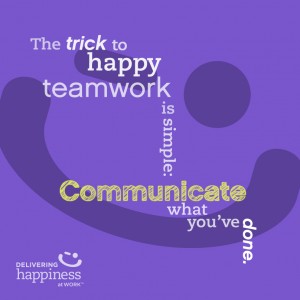Communication, Workplace Culture, Culture Inspiration, inspiration, leadership, work, communicate, productivity
 I've worked on teams where everyone has great offices, great views, great coffee, great ergonomic chairs, and their very own stapler. There were catered team lunches, conference calls, email chains, our own private offices, but not one of us was happy.
I've worked on teams where everyone has great offices, great views, great coffee, great ergonomic chairs, and their very own stapler. There were catered team lunches, conference calls, email chains, our own private offices, but not one of us was happy.
Building a talented, brilliant team of individuals isn’t hard. You just hire the right people. Building a happy team out of those talented, brilliant individuals, however, is incredibly difficult. More often than not, you see the right people become dissatisfied, disengaged and stressed out. On the rare occasion you do see them happy, enthused and productive, you wonder what is in the company water cooler.
The trick to happy teamwork is simple: Communicate what you've done.
Why does this trick work? First, let’s get at why so many teams of bright, hard-working people can become so sullen and stressed. Imagine a team tasked with resolving a complex problem in a limited amount of time. Everyone retreats into what’s commonly believed as the most productive mode – heads down, working furiously on their own. All initially motivated and driven, they get frustrated when they aren’t making progress quickly enough. And because each team member doesn’t quite realize what the other is doing, everyone starts feeling the weight of the whole project’s inadequate progress on their own shoulders. This misguided perception that they are alone in doing all the real work breeds disengagement and resentment.
In contrast, happy teams make it part and parcel of everyone’s job to prevent this from happening. The process of pulling your weight and contributing your talents to the division of labor isn’t finished until everybody conveys what they’ve done to each other.
Communicating the work that has been done serves two purposes, both of which affect and ensure team happiness. First, you personally score. Not only do you get to derive a sense of accomplishment and contribution to a larger cause, you also open up opportunities to receive recognition, thanks, encouragement, and helpful feedback from your colleagues. All these benefits fuel your motivation to continue making progress.
Second, telling others what you’ve done has huge group happiness benefits. Your progress becomes the whole team’s progress. By lessening the collective insecurity that nothing is getting done fast enough, you prevent your team from going into the isolationist work mode that disconnects and frustrates.
Moreover, communicating what you've done has the practical effect of making the whole team more productive. Tom Sachs, a contemporary sculptor known for complex recreations of modern engineering and design masterpieces, imposes this rule in his studio: doing your work is only half your job. Sachs explains:
“[S]ent does not mean received is a profound thing. Half of your job in this studio is doing your work, the other half of your job is communicating that it’s been done. Because if you do it, and I don’t hear about it, how do I know what’s going on? I’m not trying to control everything, but in an intimate work environment, where we’re really trying to develop something complex, a nod saying, ‘I got it,’ helps moves things along.”
Moving things along is a huge part of your job if you’re a member of a team, especially if you want that team to be happy. Our productivity, motivation and happiness are hypersensitive to any setbacks, distractions or even mere delays. The moments when we do our best work can be amplified if everyone steps out of themselves to ensure that the team hums along like a well-oiled machine.
The surefire way to do that? Do what you do best. And then tell someone about it.
About Ginni
 Ginni Chen is Chief Happiness Officer at iDoneThis, a team-building tool that tracks, shares and celebrates your accomplishments. When not striving for the happiness of iDoneThis members, she’s a rock climbing instructor, skier and collector of first edition books. You should follow her on Twitter at @GinniChen.
Ginni Chen is Chief Happiness Officer at iDoneThis, a team-building tool that tracks, shares and celebrates your accomplishments. When not striving for the happiness of iDoneThis members, she’s a rock climbing instructor, skier and collector of first edition books. You should follow her on Twitter at @GinniChen.